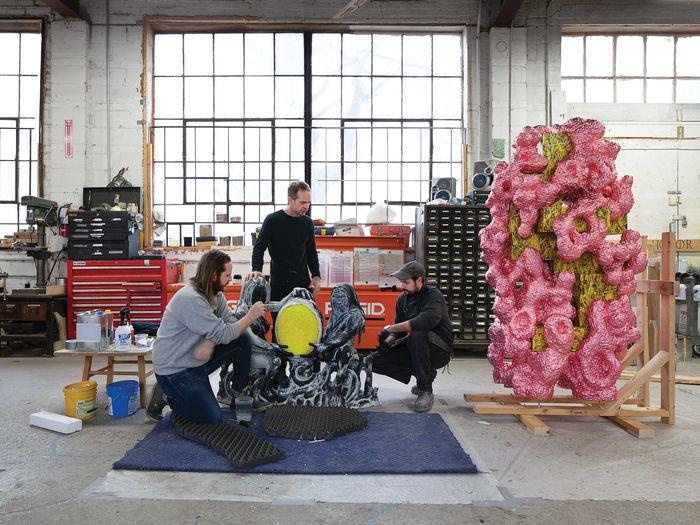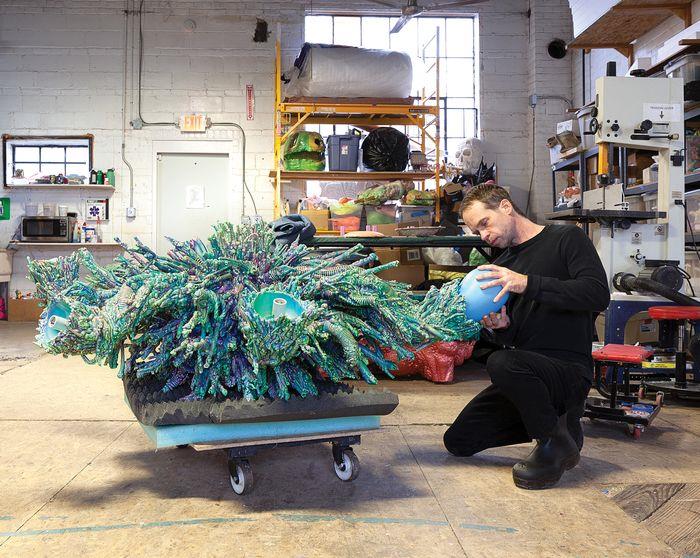By Stephen Wallis
Photography by Corine Vermeulen for WSJ. Magazine
“Terrifying” is how Chris Schanck sums up a sculptural bench nearing completion in his studio on the east side of Detroit. “I drew it and thought, Wait, how?”
Schanck, 46, whose handcrafted creations fall into a hard-to-define category where art and design collide, is producing the bench as a centerpiece of his first full-scale solo museum exhibition, opening at New York’s Museum of Arts and Design (MAD) on February 12. As with everything he makes, it was born out of his imaginative drawings, but it represents a notable shift toward figurative works that are explicitly narrative – and intensely personal.

The bench’s high-back circular seat, ornamented with cascades of serpentine swirls, is made with a welded steel frame and sculpted blocks of foam, all covered in layers of resin and shimmering foil, a process Schanck developed while studying at the nearby Cranbrook Academy of Art. Crowning the piece are two seated figures facing each other, a skull at their feet. It’s an interpretation of the classic Death and the Maiden motif, and both figures are modeled on Schanck himself. Their hands hold a head whose translucent resin face, rendered in the manner of a Renaissance grotesque mask, will emit a Gatorade-green glow, thanks to a light inside.
Schanck says the idea for the bench emerged during the Covid pandemic, when he found inspiration in the memento mori, including Death and the Maiden motifs, that proliferated in European art after the Black Death plague. “They were a reminder to live your life more fully—not to fear death but to seize the day,” says Schacnk, who is also creating a mirror for the MAD exhibition with relief-carved figures inspired by Sylvia Plath’s poem “Mirror,” a meditation on aging and the end of life. While such allusions might suggest intense self-reflection, he hopes these pieces project a positive, even optimistic spirit.

It’s the sort of balancing act that characterized all of Schanck’s work, which bridges the industrial and luxurious, the crude and refined, the kitschy and cool. His breakout pieces were his tables, chairs and cabinets made with foam carved to resemble crumbling, encrusted stone or decaying wood. Schanck added the alchemic step of embellishing their surfaces with aluminum foil, at first using ordinary kitchen foil and later shifting to colorful candy-wrapping varieties. Everything then gets sealed in layers of glossy resin.
In the world of fashion. Designer William Sofield furnished the Tom Ford flagship on Madison Avenue with a console and chair, while architect Peter Marino commissioned Schanck to create benches for more than a dozen Dior boutiques worldwide. More recently, Bottega Veneta installed several of Schanck’s pieces at its Detroit pop-up shop.
Schanck’s creations are as appealing to luxury brands looking to distinguish themselves as they are to bespoke-minded collectors. Prices typically start around $30,000 and run to $150,000 for original pieces from Friedman Benda, his New York dealer. (He recently signed on with the David Gill Gallery in London, wehre he’ll have a show early next year.)
“It’s work that appeals to adventurous collectors,” says interior designer Michael Lewis, who often commissions pieces from Schanck for clients. “He has an enormously intellectual approach, and he’s always pushing the boundary to achieve something new.”










